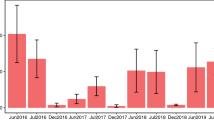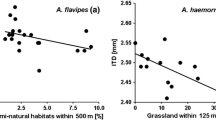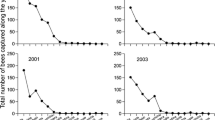Abstract
Claims have been made for a canopy preference by large bees pollinating tropical flowers—without data or tests that support or refute this opinion. The working hypothesis for bee foraging behavior in three dimensions is that forager experience can produce stratum fidelity, just as rewarding foraging produces floral fidelity. Wideranging search behavior should allow bees to track spatiotemporal distribution of resources. A systematic study of 20 bee species and 10 genera: Apis, Trigona, Eulaema, Centris, Euglossa, Scaptotrigona, Partamona, Megalopta, Rhinetula,and Oxytrigonawas made in two forests in Panama. Two traps were operated simultaneously at canopy height and in the understory to test whether there were consistent stratum associations. Studies were continuous for 1 and 8 years. The only high-canopy foragers were two nocturnal bees, all the rest flew at both heights with similar probability or consistently came to lower traps. Large euglossines showed a tendency to forage high, which was directly related to their capacity for heat loss during flight, compared to smaller euglossines. They are also more conspicuous in warning coloration, another expected correlate of foraging more often in the open. Although large variance in stratum association predominates, some medium-sized diurnal forest bees avoid the exposed upper canopy, while some nocturnal bees tend to forage there.
Similar content being viewed by others
References
Ackerman, J. D. (1983). Specificity and mutual dependency of the orchid-euglossine bee interaction.Biol. J. Linn. Soc. 20: 301–314.
Bawa, K. S. (1990). Plant-pollinator interactions in tropical rain forests.Annu. Rev. Syst. Ecol. 21: 399–422.
Bawa, K. S., Bullock, S. H., Perry, D. R., Coville, R. E., and Grayum, M. H. (1985). Reproductive biology of lowland rain forest trees II. Pollination systems.Am. J. Bot. 72: 346–356.
Becker, P., Moure, J. S., and Peralta, F. J. A. (1992). More about euglossine bees in Amazonian forest fragments.Biotropica 23: 586–591.
Campos, L. A. O., da Silveira, F. A., de Oliveira, M. L., Abrantes, C. V. M., Morato, E. F., and de Melo, G. A. R. (1989). UtilizaÇÃo de armadilhas para a captura de machos de Euglossini (Hymenoptera, Apoidea).Revista Brasil. Zool. 6: 621–626.
Casey, T. M., May, M. L., and Morgan, K. R. (1985). Flight energetics of euglossine bees in relation to morphology and wing stroke frequency.J. Exp. Biol. 116: 271–289.
Chappell, M. A. (1984). Temperature regulation and energetics of the solitary beeCentris pallida during foraging and intermale mate competition.Physiol. Zool. 57: 215–225.
Darwin, C. (1876).Cross and Self-Fertilisation in the Vegetable Kingdom, J. Murray, London.
Dressler, R. L. (1982). Biology of the orchid bees (Euglossini).Annu. Rev. Ecol. System. 13: 373–394.
Frankie, G. W., Haber, W. A., Opler, P. A., and Bawa, K. S. (1983). Characteristics and organization of the large bee pollination system inthe Costa Rican dry forest. In Jones, C. E., and Little, R. J., (eds.),Handbook of Experimental Pollination Biology, Van Nostrand Reinhold, New York, pp. 411–448.
Frankie, G. B., Vinson, S. B., Newstrom, L. E., Barthell, J. F., Haber, W. A., and Frankie, J. K. (1990). Plant phenology, pollination ecology, pollinator behavior and conservation of pollinators in neotropical dry forest. In Bawa, K. S., and Hadley, M. (eds.),Reproductive Ecology of Tropical Forest Plants, United Nations Educational Scientific and Cultural Organization, Man and the Biosphere Series, Vol. 7, Parthenon, Carnforth, UK.
Heinrich, B. (1976). Foraging specializations of individual bumble bees.Ecological Monographs 46: 105–128.
Heinrich, B., and Buchmann, S. L. (1986). Thermoregulatory physiology of the carpenter bee,Xylocopa varipuncta.J. Comp. Physiol. B 156: 557–562.
Jander, R. (1975). Ecological aspects of animal orientation.Annu. Rev. Syst. Ecol. 6: 171–188.
Janzen, D. H. (1981). Bee arrival at two Costa Rican femaleCatasetum orchid inflorescences, and a hypothesis on euglossine population structure.Oikos 36: 177–183.
Karr, J. R. (1972). A comparative study of the structure of avian communities in selected Panamanian and Illinois habitats.Ecol. Monogr. 41: 207–233.
Kato, M., Roubik, D. W., and Inoue, T. (1992). Foraging behavior and concentration preference of male euglossine bees (Apidae: Hymenoptera).Tropics 1: 259–264.
MacArthur, R. H. (1958). Population ecology of some warblers of northwestern coniferous forests.Ecology 39: 399–415.
May, M. L., and Casey, T. M. (1983). Thermoregulation and heat exchange in euglossine bees.Physiol. Zool. 56: 541–551.
Michener, C. D. (1990). Classification of the Apidae (Hymenoptera).Univ. Kans. Sci. Bull. 54: 75–164.
Peng, R. K., Sutton, S. C., and Fletcher, C. R. (1992). Spatial and temporal distribution patterns of flying Diptera.J. Zool. 228: 329–340.
Perry, D. A., and Starrett, A. (1980). The pollination ecology and blooming strategy of a neotropical emergent tree,Dipteryx panamensis.Biotropica 12: 307–311.
Roubik, D. W. (1979). Africanized honey bees, stingless bees, and the structure of tropical plant-pollinator communities. In Caron, D. (ed.),Proceedings of the IV International Symposium on Pollination, Maryland Agricultural Experiment Station Miscellaneous Publication 1.
Roubik, D. W. (1989).Ecology and Natural History of Tropical Bees, Cambridge University Press, New York.
Roubik, D. W. (1990). Niche preemption in tropical bee communities: A comparison of neotropical and malesian faunas. In Sakagami, S. F., Ohgushi, R., and Roubik, D. W. (eds.),Natural History of Social Wasps and Bees in Equatorial Sumatra, Hokkaido University Press, Sapporo, Japan.
Roubik, D. W. (1992). Loose niches in tropical communities: Why are there so few bees and so many trees? In Hunter, M. D., Ohgushi, T., and Price, P. W. (eds.),Effects of Resource Distribution on Animal-Plant Interactions, Academic Press, San Diego, CA.
Roubik, D. W., and Ackerman, J. D. (1987). Long-term ecology of euglossine orchid-bees (Apidae: Euglossini) in Panama.Oecologia 73: 321–333.
Roubik, D. W., and Moreno, J. E. (1991).Pollen and Spores of Barro Colorado Island, Monographs in Systematic Botany, No. 36, Missouri Botanical Garden, St. Louis.
Roubik, D. W., and Wolda, H. (1993). Pollinator population dynamics on a tropical forest island: 15 years, three El Niño events, and colonization by African honeybees (submitted for publication).
Roubik, D. W., Ackerman, J. D., Copenhaver, C., and Smith, B. H. (1982). Stratum, tree and flower selection by tropical bees: Implications for the reproductive biology of outcrossingCochlospermum vitifolium in Panamá.Ecology 63: 712–720.
Stone, G. N., Amos, J. N., Stone, T. F., Knight, R. L., Gay, H., and Parrott, F. (1988). Thermal effects on activity patterns and behavioral switching in a concourse of foragers onStachytarpheta mutabilis (Verbenaceae) in Papua New Guinea.Oecologia 77: 56–65.
Sutton, S. L., and Hudson, P. J. (1980). The vertical distribution of small flying insects in the lowland rain forest of Zaire.Zool. J. Linn. Soc. 68: 111–123.
Waddington, K. D. (1979). Divergence of inflorescence height: An evolutionary response to pollinator fidelity.Oecologia 40: 43–50.
Whitten, W. M., Young, A. M., and Williams, N. H. (1989). Function of glandular secretions in fragrance collection by male euglossine bees (Apidae: Euglossini).J. Chem. Ecol. 15: 1285–1295.
Willmer, P. G. (1991). Constraints on foraging by solitary bees. InBehavior and Physiology of Bees, Goodman, L. J., and Fisher, R. C. (eds.), CAB International, Wallingford, UK.
Wolda, H., and Roubik, D. W. (1986). Nocturnal bee abundance and seasonal bee activity in a Panamanian forest.Ecology 67: 426–433.
Author information
Authors and Affiliations
Rights and permissions
About this article
Cite this article
Roubik, D.W. Tropical pollinators in the canopy and understory: Field data and theory for stratum “preferences”. J Insect Behav 6, 659–673 (1993). https://doi.org/10.1007/BF01201668
Accepted:
Issue Date:
DOI: https://doi.org/10.1007/BF01201668




